About Vance | CALL resources main page & Site Index | Vance's papers and presentations
![]()
About Vance |
CALL resources main page
& Site Index |
Vance's papers and
presentations
Institutionalizing Web 2.0 for Learning in the Arab Region |
Presented at the Alexandria
Library, Egypt
at a conference convened to discuss:
New Learning for Sustainability in
the Arab Region
Motivating Change: New Learning in Formal Education for
Sustainable Development
30 August - 1 September 2007
Through a recommendation on Jay Cross' Internetime Ning, I was invited to speak on 31 August, in session 3 of the "New Learning for Sustainability in the Arab Region" meeting in Alexandria, Egypt. The conference seeks regionally-based experts working in informal learning, web 2.0, active bloggers, etc.
This presentation is online
Abstract (106 words) - This talk addresses prospects for introducing Web 2.0 in Arab education systems. Although Web 2.0 is seen by advocates as having transformational influence on educators and students, its uptake from informal to formal learning situations proceeds slowly in the Arab region. This talk identifies ten aspects of the paradigm shift required for Web 2.0 acceptance, and ways that educators can act as change agents for themselves primarily, but affecting eventually their institutions as these reflect the stakeholders changing themselves and those around them.
Introduction
As I was about to go on leave last June (2007) there occurred on a teachers' list I follow a classic thread. It was beginning to dawn on the teaching professionals on this list, many of them teachers of Arab learners (as the list is administered and moderated in the UAE) that their students were about to toss their books aside for the summer and forget much of what they had been 'taught' so painstakingly the year before. The posts explored how the students might be given 'assignments' for summer work, or motivated to keep diaries. When it occured to the list participants that motivation was going to be lacking in these students, I chimed in with the suggestion that the teachers might try introducing their students to blogging. The problem with motivating students to keep paper based diaries or journals is that there is essentially no audience for them. Some students might write in them to impress a teacher they respect, but only in rare cases would this sustain itself during a summer holiday.
Blogging on the other hand exposes students to a world-wide audience. A blogging habit is happily coincidental with a technology-rich learning environment (wherever that happens to be: school, home, the city). Blogs are also in tune with sophisticated ways that knowledge is distributed over the Internet, which in turn contributes to tapping in to that world-wide audience. Facilitators of learning (as opposed perhaps to 'teachers') in schools and informal learning situations all over the world are reporting remarkable results from having students blog. Their results are documented in teachers' blogs, podcasts, videos on YouTube (and TeacherTube), in other artifacts scattered over the Web attesting to their successes.
However, such evidence tends to be accessed mainly by people who not only use but explore and are fascinated with the Internet , and particularly Web 2.0, and its potential for education. The (dwindling) majority of teachers not so predisposed tend to be unimpressed with evidence presented in media that they prefer to ignore, and so my intrusion in that list discussion just mentioned was met with silence, and the list carried on discussing how students could be coerced into practicing their writing into a summer where no teachers would be wielding deadlines or sanctions.
Changing the learner paradigm: How are tools such as Web 2.0 in formal education changing the learner paradigm in content creation, and how are we seeing this in the Arab region?
This anecdote illustrates the state of paradigm shift in education as reflected in this small cohort of expatriate language teachers in the Middle East, but I think it's fairly typical of attitudes in the region. I have been in the Arab world for most of my teaching career but I keep abreast of what's going on in my profession through use of numerous CMC (computer-mediated communication) devices. These devices, these means of communicating with professional teaching peers constantly both synchronously and asynchronously, have revolutionized what it means to be an expat teacher in the Middle East. When I started teaching in the area in the 1970's and through the mid-90's to be expat meant you were 'out of the loop'. It meant that if you stayed away too long you were assumed to be falling behind in your career, that you were trading the ability to stay on top of your game for the material benefits of life overseas, and many aging expats at the time got caught in the cycle of contract renewals, unable to compete for jobs back in the real world, partly because they had simply lost their edge.
Now that we have Web 2.0, the conversational read-write web, an ability to get information online almost instantly and interact with others in distributed peer-to-peer learning networks (distributed means that the members of the community can be almost anywhere in the world, wherever there is an Internet connection) it is possible to stay abreast of new developments in your profession as easily as anyone living in Europe or North America. Not only that, but you can communicate directly with the experts in your profession ... and read what they are writing and hear what they are saying the instant the words leave their computer. To be an expat now no longer means you are without knowledge and resources (caveat: on the 'wired' side of the digital divide -- and where wealth has been used equitably in the Arab world, the people in the region have good access to Internet resources).
However, to take advantage of the new technologies in one's learning or professional development, a change of thinking is required. Yet in North America, Europe, in the Middle East and elsewhere there are professionals who have not made the adjustments necessary. And getting back to the anecdote that I started off with, the list members who were wondering how to motivate their students to write in journals using the old, static, minimally interactive technologies of pen and paper, had clearly not made the paradigm shift that might have led to renewed learning opportunities for their students this very summer.
Let's examine the nature of the shift required. There are many ways that thinking about education must be readjusted. I have listed ten such aspects below which the teachers mentioned earlier had not made. Interleaved here we can speculate on what kind of outcomes might have been achieved, had the teachers made these adjustments. Or put another way, what should these teachers do starting now in order to reverse this situation for next summer?
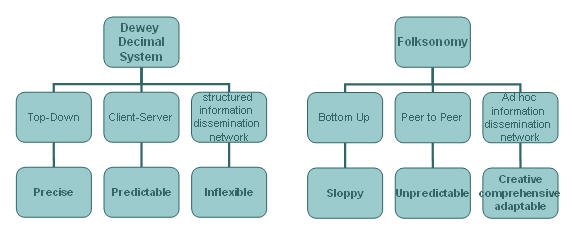 .
.There are many allusions to paradigm shift in the well-known video "The machine is us/using us" by Michael Wesch. From the transcription in his blog, Digital Ethnography @ Kansas State University http://mediatedcultures.net/ksudigg/?p=78, Wesch says:
"We'll need to rethink a few things… We'll need to rethink copyright We'll need to rethink authorship We'll need to rethink identity We'll need to rethink ethics We'll need to rethink aesthetics We'll need to rethink rhetorics We'll need to rethink governance We'll need to rethink privacy We'll need to rethink commerce We'll need to rethink love We'll need to rethink family We'll need to rethink ourselves."
Regional overview: How institutions are benefiting from web 2.0 and new learning technologies and how this compares to other regions
This is the interesting question: how are institutions benefiting? The equally interesting answer, considering the potential, is that by and large, those in the Arab world are not (... yet). I follow podcasts produced by educators who tend to be in North America and at the forefront of using Web 2.0 technologies in the classroom and these teachers report phenomenal results in working with students. They speak of transformational effects and empowering students to develop powerful heuristics for learning. They speak of "preparing students for jobs that don't yet exist, using technologies that haven’t yet been invented" (from Fisch: Shift Happens). They acknowledge the down side of using social networking in the classroom, the exposure to predators and unsavory elements, but argue for greater freedom in helping students to explore all available Internet tools with analogies such as, do we prevent students from crossing the street, or train them to look both ways? Where better than in schools to inculcate appropriate use of the entire gamut of tools available on the Internet? The kids are going to use them anyway, why not help everyone make that "transfer" (point 3 above).
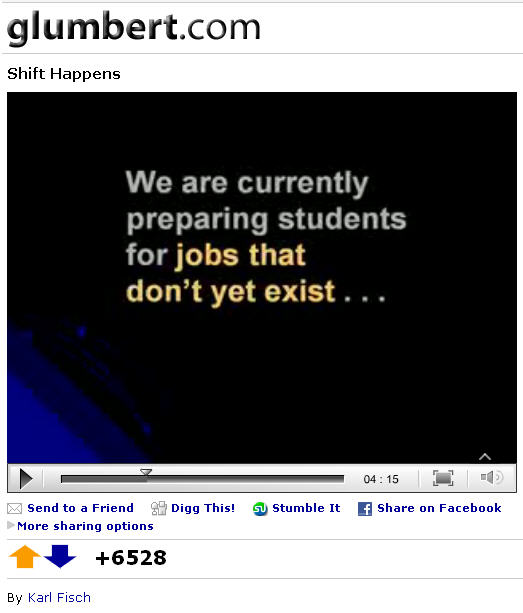
But even these teachers speak of working in isolation, of constantly having to overcome resistance. The present situation seems to be that some minority of teachers have an awareness of the potential of Web 2.0 and are trying to utilize it. These teachers tend to be the younger ones, the emerging generation of digital natives (Prensky, 2001). The more experienced teachers and administrators are having more difficulty making that paradigm shift, or even recognizing the need for one. The reaction of the teachers on the mailing list I spoke of earlier was illustrative of this. I entered their discussion on how to get students writing over the summer using traditional paper-based print literacies. I suggested blogs. The reaction was silence and then a resumption of the discussion on how to getting students writing over the summer using traditional paper-based print literacies.
Introducing innovations: What is the process of introducing innovation like this into a traditional institution?
Terry Freedman (2006) created an excellent podcast on how to be an effective change agent, and what to avoid when acting in that capacity. For example, one should assume that those one is trying to change are equally sincere in wanting to do their jobs well, and one should avoid taking on a superior tone, one should anticipate counterarguments and be prepared to address them, and so on.
I wish I could speak more optimistically on the issue of institutionalizing Web 2.0 in the institutions I've come in contact with in the region where I work. I have worked extensively in Oman and the UAE and have given talks and workshops in Egypt and Tunisia, and am scheduled to give workshops soon in Sudan. Of these countries, the UAE is the most developed regarding e-learning, but even here resistance to change is deeply ingrained. Teachers with with a working knowledge of Web 2.0 tools are only a small fraction of those working at institutes of higher learning in the UAE, where the teaching tends to the traditional. Teachers talk, students listen and then do, and then are tested. If students are asked to do something not to be tested it upsets them, and one's colleagues may not be entirely comfortable with any one teacher departing too obviously from the prescribed curriculum. Finally, the tools for evaluation of both student and teacher performance (by students and supervisors) can discourage departure from expected behaviors.
This situation is not unique to the Middle East. I delivered a series of lectures in Spain this summer and was surprised to hear teachers there complaining of similarly rigid systems constraining their utilization of Web 2.0 tools. It seems that in order to bring change to such systems, there must be a paradigm shift in thinking at the top, where the rules are currently made, OR perhaps the so-called subversive elements of Web 2.0 will seep up from the grass roots at some time in the future when teachers themselves are blogging and creating their own wiki-based textbooks (in conjunction with their students), and make their voices heard that way.
This is what Web 2.0 is about: empowerment of individuals in what has come to be known as the long tail (Anderson, 2004). Teachers are themselves individuals, and we know that teachers work to impact individual students, so the process of change is taking place in that way at the moment, on an individual basis. And these individuals in aggregate will eventually bring about change once they 'become' their institutions.
As regards sustainability, my expertise is in the formation of communities of practice (CoPs) through use of CMC and social networking tools, especially as articulated through the blogosphere. These tools are used by teachers to explore modern technology-enhanced teaching methods, and of course by students to pursue any line of enquiry, often in the course of improving their use of a target language. In any of these contexts, a valid line of inquiry could be environmental sustainability. These tools can be applied to students studying the problem with students in other nations and cultures at a distance. The techniques enhance community building, and an awareness within the community of the scope of the problem, possible ways to resolve it, and how to overcome resistance to suggested solutions.
In this talk I have tried to suggest that the process of institutionalizing Web 2.0 hinges on how informal learning informs on institutional learning. In fact, you can't have the latter without the former, can you? Someone has to learn something informally in order to be in a position to organize institutional learning. It's not chicken and egg, it's cart and horse. That's exactly the position we're in regarding institutionalizing web 2.0. Practitioners are learning about it informally and more and more are engaged in the process of institutionalizing what is being learned by the early adaptors.
Buthaina Al Othman took this picture while I was telling people what the conference tag was
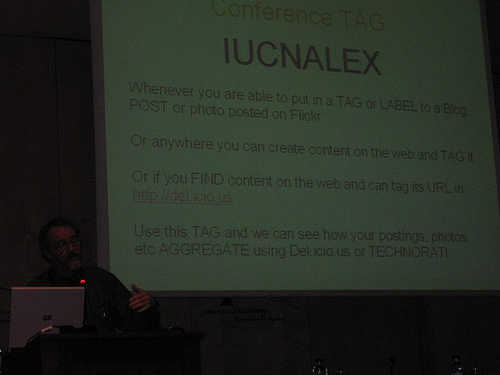
http://flickr.com/photos/44124286249@N01/1283855770/
She immediately Twittered it:
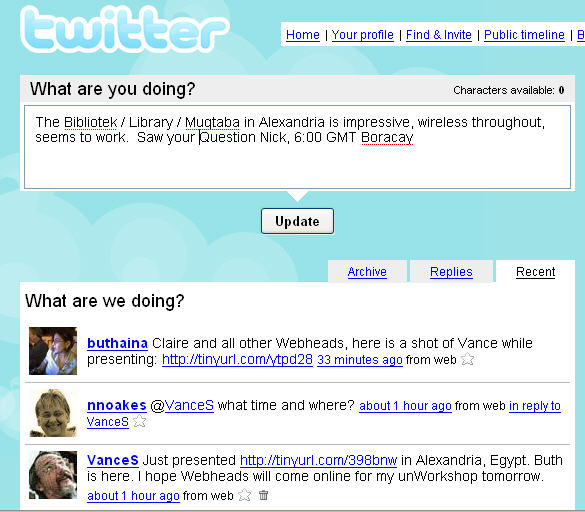
She gave it the conference tag, so it could also be found in a Technorati search on http://www.technorati.com/photos/tag/iucnalex
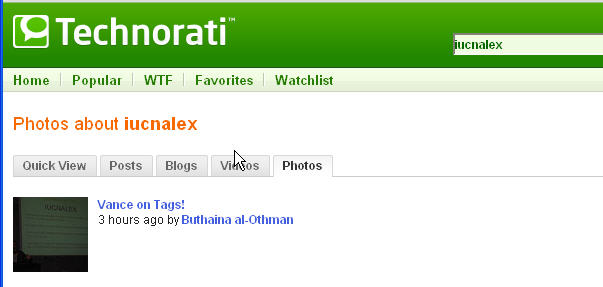
unWorkshop, following day ...
The following day we held a 2.5 hour session demonstrating various almost random aspects of connectivity.
[9/3/2007 2:01:16 AM] Jose Rodriguez says (in Skype text): "Hi Vance. Here is the raw audio from your webcast on Saturday Morning. I has 3 hours! http://www.divshare.com/download/1838379-497. Sorry I couldn't get into SL. I had bandwidth issues. I didn't want to download upgrade. I could have steamed there also. Great session."
I wrote a report of the session here (also in raw form): http://groups.yahoo.com/group/evonline2002_webheads/message/16194
Hopefully I'll have a chance to edit the raw audio and blog the wacky session report.
References
Allison, Paul. (2006). New media in the classroom: Blogging. Teachers Network: Successful teaching practices in action. VeohTV. Retrieved August 20, 2007 from: http://www.veoh.com/series/paulallison
Anderson, C. (2004). The long tail. Wired, Issue 12.10 (October 2004). Retrieved August 20, 2007 from: http://www.wired.com/wired/archive/12.10/tail.html.
Dieu, Barbara, and Vance Stevens. (2007), Pedagogical affordances of syndication, aggregation, and mash-up of content on the Web. TESL-EJ, Volume 11, Number 1. Retrieved August 20, 2007 from: http://tesl-ej.org/ej41/int.html
Fisch, Karl. (2006). Shift Happens. Retrieved August 20, 2007 from: http://www.glumbert.com/media/shift .
Freedman, Terry. (2006). Overcoming Obstacles “Selling Web 2.0 to Senior Management”. Presentation given at the 2006 K-12 Online Conference. Retrieved August 20, 2007 from: http://k12onlineconference.org/?p=72 (has links to text version, and recording).
Glogowski, Konrad and Christopher Sessums. Personal Learning Environments - Exploring Professional Development in a Networked World. Presentation at WiAOC 2007, Webheads in Action Online Convergence. Retrieved August 20, 2007 from: http://www.webheadsinaction.org/node/168. Recorded in two parts at http://streamarchives.net/..
Prensky, M. (2001). Digital natives, digital immigrants. On the Horizon 9, 5. Retrieved August 20, 2007 from: http://www.marcprensky.com/writing/Prensky%20-%20Digital%20Natives,%20Digital%20Immigrants%20-%20Part1.pdf#search=%22prensky%22digital%20native%22%22. .
Siemens, George. (2005). Connectivism: A Learning Theory for the Digital Age George . International Journal of Instructional Technology and Distance Learning 2, (1). Retrieved August 20, 2007 from: http://www.itdl.org/Journal/Jan_05/article01.htm
Stanley, Graham. (2006). Redefining the Blog: From composition class to flexible learning. In Hanson-Smith, Elizabeth, and Sarah Rilling (Eds.). Learning languages through technology. Alexandria, Virginia, USA: TESOL. pp. 187-200.
Stevens, Vance. (2007). The Multiliterate Autonomous Learner: Teacher attitudes and the inculcation of strategies for lifelong learning. Blog posting from AdVancEducation. Retrieved August 20, 2007 from: http://advanceducation.blogspot.com/2007/07/multiliterate-autonomous-learner.html.
Stevens, Vance, Nelba Quintana, Rita Zeinstejer, Saša Sirk, and Doris Molero. (2007). Writingmatrix: CONNECTing students with blogs, tags, and social networking. An online presentation given May 18, 2007 at the WiAOC online conference. Links to recording and slides retrieved August 20, 2007 from: http://webheadsinaction.org/node/174
Toledo, Cheri. (2007). The Future of Teacher Education: Herding Cats and Chasing Targets. Presentation given at the Future of Education online conference. Retrieved August 20, 2007 from: http://ltc.umanitoba.ca/foe-2007/Cheri_Toledo/.
David Weinberger and Andrew Keen debate Weinberger's thesis in his most recent book, All Things Miscellaneous, posted by Kevin Werbach July 9, 2007 in Conversations Hub: Supernova 2007. Retrieved August 20, 2007 from: http://conversationhub.com/2007/07/09/video-david-weinberger-and-andrew-keen/. For the direct video link http://conversationhub.com/podpress_trac/web/259/0/sn-weinberger-keen.mp4 .
Use the
![]() navigation at the top of this
page or your browser's BACK button to return to a
previous page
navigation at the top of this
page or your browser's BACK button to return to a
previous page
For comments, suggestions, or further information on this page, contact Vance Stevens, page webmaster.
Copyright 2007 by Vance Stevens
under
Creative Commons License:
http://creativecommons.org/licenses/by-nc-sa/2.5/